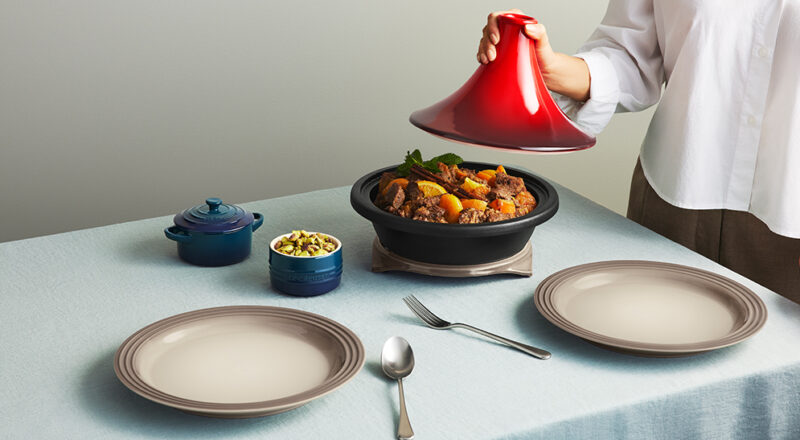Are you looking to enrich your cooking with a touch of Moroccan cuisine? The expertise and flavor nurtured within a tagine pot may be what your kitchen needs! In this article, we dive into Tagine Pot Reviews to help you find the best one for your kitchen. With a variety of styles and materials, each tagine aims to bring a unique flavor and cooking experience.
In this comprehensive discussion, we’ll explore various tagine pots available today, focusing on their key features, benefits, and tips for selecting one that will turn your culinary endeavors into success stories.

What is a Tagine Pot?
A tagine pot is a traditional North African cookware, famed for its unique design and use in Moroccan cooking. Made from ceramic or clay, this cooking vessel comprises a circular base and a conical lid. The tagine pot’s shape aids in circulating steam, ensuring food is cooked evenly and retaining moisture.
The Importance of Using a Tagine Pot
Choosing a tagine pot for your cooking needs offers a journey into cultural culinary experiences. The pot does not only cook your meals but also infuses a unique flavor developed through traditional techniques. As a cooking professional, leveraging the design and functionality of this vessel can immensely impact the taste and texture of your preparations.
The Benefits of Cooking with a Tagine
Tagine pots provide several advantages that are beneficial for both newbie cooks and professionals:
- Flavor Enhancement: Slow cooking at low temperatures captures and seals flavors.
- Moisture Retention: The design keeps food moist, preventing dryness.
- Energy Efficiency: Low and consistent heat saves energy.
Comparing Different Tagine Materials
In the quest for the best tagine pot, understanding the types of materials used in their construction is crucial. Common materials include:
- Ceramic Tagine: Suitable for its elegance and smooth cooking surface. Perfect for oven and table presentation.
- Clay Tagine: Known for enhancing the earthy flavor. Ideal for slow cooking over low heat.
- Cast Iron Tagine: Provides durability and heat retention. Compatible with modern stovetops.
Key Features to Consider in a Tagine Pot
When selecting a tagine pot, consider these essential features:
1. Size
Based on your serving needs, tagines come in various sizes. Whether cooking for one or many, choosing the right size affects the overall cooking experience.
2. Material
Selecting the material influences compatibility with cooking surfaces, including stovetops and ovens, as well as the flavor development.
3. Design
The aesthetics and shape contribute to how effectively the tagine pot retains moisture and circulates heat.
Best Tagine Pots Reviewed
While reviewing various products, some standout tagine pots in the market today include:
- Emile Henry Ceramic Tagine: Renowned for exceptional quality, holds heat effectively.
- Le Souk Ceramique Tagine: Offers a hand-painted finish, combining beauty and functionality.
- Lodge Cast Iron Tagine: Appreciated for its durability, pressure resistance, and ability to withstand extreme heat.
Tagine Pot Recipes to Try
Once you’ve procured your perfect tagine pot, discover some delightful recipes such as Moroccan chicken or lamb tagine with apricots. Find inspiration for more tagine recipes here.
Where to Buy Quality Tagine Pots?
Finding a tagine pot does not have to be a chore. Seek reviews from culinary stores and websites renowned for high-quality kitchenware.
Maintenance Tips for Your Tagine
Proper care extends the lifespan of your beloved tagine pot. Here are a few maintenance tips:
- Gently hand wash with mild soap and avoid abrasive cleaners.
- Ensure the tagine pot is completely dry before storing.
- Avoid thermal shock by letting it cool gradually after use.
Integrating Tagines into Your Professional Cooking
Incorporating a tagine pot can significantly enhance the profile of your kitchen, providing richness and diversity to your menu offerings. Professionals can blend traditional methods with modern tastes, keeping dishes delectable and guests satisfied.

Tips for Mastering Tagine Cooking Techniques
- Opt for the freshest ingredients to enhance the tagine’s flavors.
- Experiment with spices and herbs to diversify the taste.
- Allow sufficient cooking time for optimal tenderness.
Frequently Asked Questions (FAQs)
1. Can I use a tagine pot on a stovetop?
Yes, however, using a heat diffuser is recommended to distribute the heat evenly and prevent damage to ceramic or clay tagines.
2. Does the tagine pot require seasoning?
While some clay tagines might benefit from initial seasoning, most modern ceramic and cast iron variants do not require it.
3. What kind of foods can I cook in a tagine pot?
A tagine pot is versatile. From slow-cooked meats to fragrant vegetarian dishes, the options are abundant.
For those passionate about perfecting this art, check our in-depth insights on related culinary tools. Explore our analysis of burger presses for further creative culinary enhancements. Happy cooking!
This article contains affiliate links. We may earn a commission at no extra cost to you.

